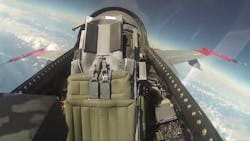Boeing to convert group of F-16 jet fighters to unmanned target drones
EGLIN AIR FORCE BASE, Fla. - Military avionics experts at Boeing will convert several retired U.S. Air Force Lockheed Martin F-16 jet fighters into sophisticated manned and unmanned target drones under terms of an $11.2 million order.
Officials of the Air Force Life Cycle Management Center at Eglin Air Force Base, Fla., are awarding a contract modification to Boeing Defense, Space & Security in St. Louis to convert about 15 F-16 fighters into unmanned QF-16 full-scale aerial targets (FSATs). This order involves QF-16 full-scale aerial target lot 5B.
The U.S. Air Force continues to convert old F-16 jet fighters to unmanned target drones to help train combat pilots, as well as to test advanced anti-aircraft missiles.
The Air Force has used converted jet fighters as target drones for decades, beginning in the 1960s, to test sophisticated missiles and electronic warfare systems. Some retired jet fighter target drones are destroyed during weapons tests, but often the drones rely on onboard sensors to calculate the point of missile detonations to record "kills" without destroying the target aircraft.
The QF-16 target drones are replacing the Air Force's fleet of QF-4 target drones, which are converted McDonnell Douglas F-4 Phantom jet fighters, which were phased out of active service in the 1980s. The newer QF-16s bring a new level of sophistication to U.S. supersonic target drone capability. The F-16 is a fourth-generation fighter, and brings new challenges for weapons testing over the third-generation F-4.
Boeing started converting F-16s into QF-16 drones in 2010. Company experts strip down retired F-16 fighters to remove unnecessary parts like the jet's 20-millimeter cannon and APG-66/68 radar. Boeing alters the aircraft to fly unmanned or with human pilots. Boeing also installs a flight termination system that can destroy the drone if it goes out of control, command telemetry systems so operators can control the drone can be controlled from the ground, a scoring system to gauge the accuracy of air-to-air missiles fired at the drone, as well as avionics packages to enable the planes to fly unmanned.
Air Force leaders are expected to buy a total of 120 QF-16 target drones through 2019. Optionally Air Force leaders are considering buying a total of 210 QF-16 through 2022. The fleet should last until 2025.
On this contract, Boeing will do the work in St. Louis, and should be finished by April 2021.
For more information visit Boeing Defense, Space & Security online at www.boeing.com/defense.

